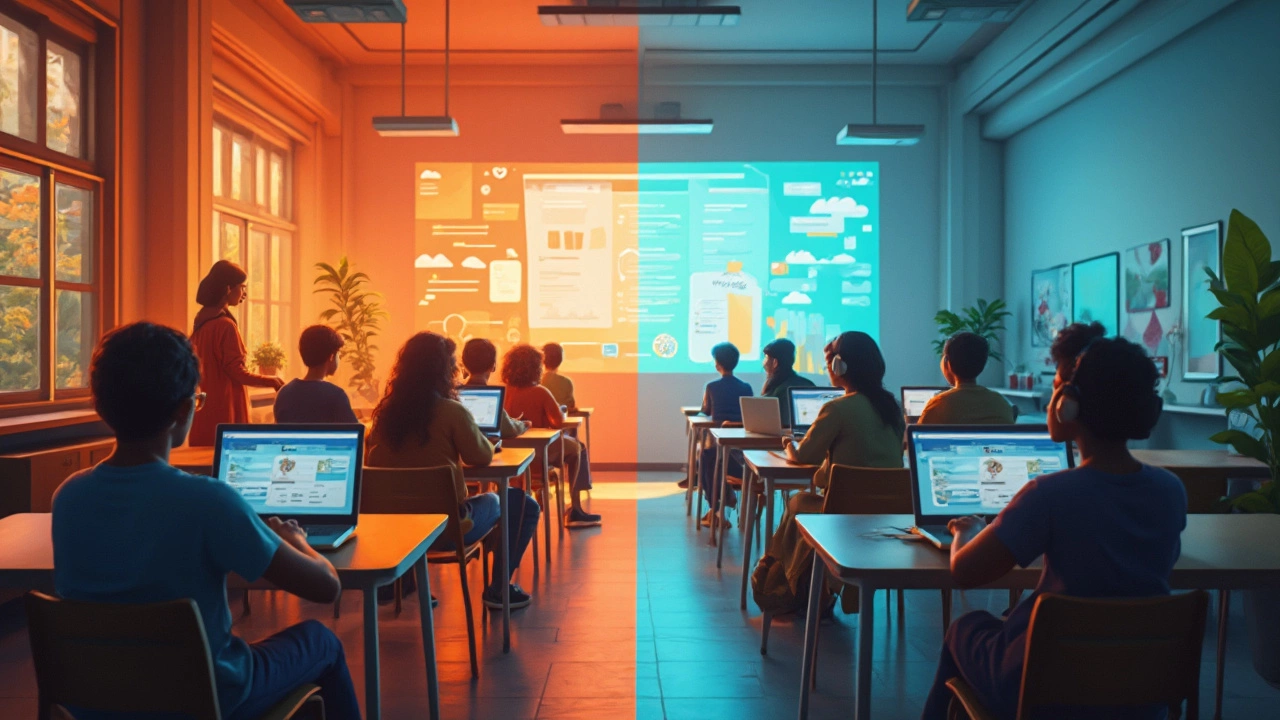A lot of folks mix up virtual learning and eLearning, tossing the words around like they're twins. But they aren't the same. Both might get you on a screen in your pajamas, but how you actually learn is totally different.
Here's the deal: eLearning is all about using computers or tablets to access courses, videos, quizzes, or even podcasts—usually whenever you want, at your own pace. It's like having a digital workbook and a smart guide in your pocket, ready when you are. Virtual learning, though, often means live sessions with a real teacher or classmates, just not in the same room. Think of a Zoom class where you're all showing up at the same time, chatting, and maybe even breaking out into smaller groups.
The world of online education exploded after 2020 (thanks, pandemic), but picking the right style can still trip people up. If you've ever wondered why some platforms have scheduled sessions and others let you click through lessons at midnight, knowing this difference is the first step. Stick with me, because by the end you'll know exactly how to spot which kind fits your life—and which one just won't work if you're juggling a needy dog like Luna or a chatty parrot like Mango.
- Breaking Down the Basics: What 'Virtual' and 'eLearning' Mean
- Key Differences in How They Work
- Which Suits Who? Use-Cases That Matter
- Smart Tips for Picking The Right One
Breaking Down the Basics: What 'Virtual' and 'eLearning' Mean
If you search for virtual learning or eLearning platforms, you’ll see everything from live classrooms to self-paced videos. So what’s what? Getting this straight is key because one size rarely fits all.
Virtual learning is when students and teachers meet in a digital space at the same time, usually through video calls or live chat. It feels like a real classroom—except you can’t pass notes (or at least, not as easily). This is also called synchronous learning. You get to ask questions, chat with classmates, and sometimes do group projects in real-time.
eLearning is the broader term. It covers any learning that uses digital tech—not just live video, but also recorded lectures, digital quizzes, and interactive lessons you work through on your own schedule. This can be called asynchronous learning. Platforms like Coursera, Udemy, and Khan Academy are classic eLearning spaces.
Need hard proof these terms matter? Here’s a quick comparison to clear up the mix:
| Virtual Learning | eLearning | |
|---|---|---|
| Type | Live / synchronous (real-time) | Self-paced / asynchronous or live |
| Examples | Zoom classes, live webinars | Recorded courses, online modules, quizzes |
| Interaction | High, real-time discussion | Usually solo, forums sometimes |
| Flexibility | Requires set schedule | Learn anytime |
This isn’t just word choice—understanding the difference helps you find platforms and classes that actually fit your schedule and learning style. If you need a teacher walking you through tricky math live, virtual learning is the move. If you want to chip away at lessons between dog walks or parrot playtime, eLearning’s got your back.
Key Differences in How They Work
This is where things get interesting. Virtual learning and eLearning might both happen online, but the mechanics are actually pretty different. Knowing these differences means you can pick the right experience for how you learn best.
Virtual learning usually happens live. You log in at a certain time, often with a real teacher leading the class. It’s a lot like regular school or office training, just on a screen. There’s usually a lot of face-to-face interaction—well, face-to-screen. The good news is you can ask questions in real-time, join group activities, and maybe even do breakout discussions. Some schools even take attendance by who signs in! This setup works great for people who do better with structure or want some social contact while learning.
With eLearning, there’s much more freedom. You get all your materials online, but you access them whenever you want. Nobody’s waiting for you in a virtual classroom. Lessons might be pre-recorded videos, audio files, interactive quizzes, or step-by-step guides. A cool fact: in 2024, almost 60% of people using eLearning platforms said they liked the “learn at your own speed” vibe most. You don’t have to rush to keep up with the group—or sit around bored if you pick things up quickly.
Here’s a quick table that lays out the main differences:
| Feature | Virtual Learning | eLearning |
|---|---|---|
| Format | Live sessions, scheduled times | Self-paced, on-demand materials |
| Interaction Level | Real-time with teacher/classmates | Usually solo, sometimes forums or chat |
| Tech Needed | Mic/camera, stable internet for live video | Device with internet, flexible connection |
| Who Controls the Speed? | Teacher or set schedule | Student decides pace |
If you're the type who sticks to the calendar, virtual learning’s structure keeps you on track. Prefer learning at weird hours or squeezing in lessons around a busy schedule? eLearning gives you that space.
One thing to watch out for: technical hiccups. Virtual learning needs a steady connection for live video. eLearning is more forgiving—you can hop back in even if Luna knocks out your WiFi for a bit.

Which Suits Who? Use-Cases That Matter
This is where picking between virtual learning and eLearning really gets practical. Not everyone needs the same thing. Both have their sweet spots, and knowing those can save you a ton of hassle (and money).
If you’re someone who thrives on having a set schedule and feedback from a real person, virtual learning is usually the better pick. It’s super helpful for high school and college classes where live questions, group work, and regular teacher check-ins matter. For example, language classes with live conversation practice or workshops with lots of discussion just work better with everyone online together at the same time. The same goes for company training where talking it out with your boss or team helps it stick. A survey in 2024 found that 78% of students in live virtual classes said real-time Q&A boosted their understanding—compare that to just 42% in self-paced courses.
Meanwhile, eLearning is the king of flexibility. If your life is packed—let’s say, you’re a parent, juggling job shifts, or taking care of pets like Luna and Mango—this setup lets you chip away at lessons whenever you want. Most big platforms like Coursera or Udemy run on this style. It’s perfect if you want to boost skills solo, like learning Excel from scratch, watching coding tutorials, or prepping for certifications. You can hit pause, rewind, and work at your own pace—no guilt, no teacher waiting on you. Here’s a quick look at common setups that fit each type:
| Situation | Best Fit |
|---|---|
| Real-time debate or group projects | Virtual Learning |
| Independent skill-building (like design or coding) | eLearning |
| Remote university courses needing teacher feedback | Virtual Learning |
| Busy adults with irregular schedules | eLearning |
| Mandatory workplace compliance training | eLearning |
One more thing: don’t forget about learning style. If you’re driven but hate sitting through long video calls, eLearning’s going to feel way easier to handle. On the flip side, if you need that push from others or get more from live discussions, virtual setups are hard to beat. Bottom line? Match the platform to your life, not the other way around.
Smart Tips for Picking The Right One
Choosing between virtual learning and eLearning isn’t about which is “best”—it’s about what fits your life, learning style, and goals. Let's get real on what matters most before you sign up or spend money.
- Think about your schedule: If your days are unpredictable (say, your dog Luna needs surprise walks or a kid’s soccer game pops up), eLearning is the winner. You can learn at 2 a.m. if you want to.
- Need live interaction? If you’re someone who learns better by talking things out with a teacher or classmates, virtual learning is your lane. It keeps you accountable and you get feedback right away.
- Consider tech requirements: Virtual classrooms might need faster internet and a camera. If your Wi-Fi cuts out when Mango starts squawking, pre-recorded eLearning is less risky.
- Look at course content: Not every subject works well as a self-paced course. Language learning, group projects, or anything that relies on discussion usually is better in a virtual learning setup. But if it’s something like basic Excel skills or compliance training, eLearning gets the job done faster.
One big study by the US Department of Education found that students in online learning situations performed better, on average, than those receiving face-to-face instruction—especially when they had some control over time and pace (DOE, 2010).
"Learners who can revisit material or study at their own rhythm often achieve higher retention, as flexibility boosts engagement." — US Dept. of Education
Also, check support options. Some eLearning platforms don’t offer much help if you get stuck. With virtual learning, there’s often a teacher or even office hours. If you like a safety net, keep this in mind.
| Feature | eLearning | Virtual Learning |
|---|---|---|
| Flexible timing | ✅ | 🚫 |
| Live interaction | 🚫 | ✅ |
| Technology needed | Basic (phone/tablet) | Webcam, good internet |
| Best use-case | Self-paced, skill drills | Group work, discussions |
At the end of the day, your ideal online learning setup lets you stay motivated and actually finish what you start. Ask yourself: What’s doable in your busy life, and what helps you learn—not just click through?
